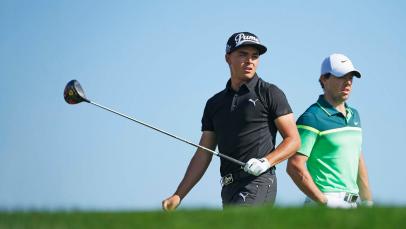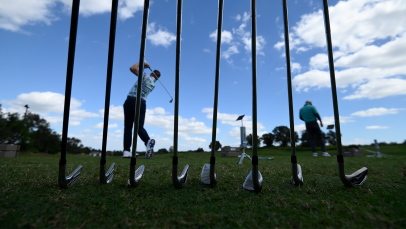DO THIS, NOT THAT
Eight ways to get smarter in how you practice and play

Photographs by Rob Liggins
Golf tips are great, but one of the complexities of getting the most out of them is context: Apply even the best information at the wrong time or in the wrong amount, and it’s like dropping in on a movie right in the middle. It can be hard to pick up the story, and you might jump to the wrong conclusions.
Here I’m going to talk about eight common instruction concepts and explain how to apply them in relation to the bigger picture, so to speak. For example, a lot of players mistakenly think they should sweep the club back aggressively and twist the face really open in the process (above, right). With the face open, pointing skyward early in the swing, you make it significantly more challenging to get it back to square by impact to produce a decent shot.
When you step back and look at the goal of the overall swing, not just the beginning of it, you start to realize that keeping the clubface square or slightly closed as it moves off the ball makes a lot more sense. Do that, and you don’t have to worry about squaring it later.
To improve your game from tee to green, I’m going to give you a tip to improve your clubface awareness (below), as well as other “do this, not that” advice. —with Matthew Rudy
PITCHING
DO THIS

How do you produce consistent height and distance on pitch shots? It comes from returning the club to impact with the loft and shaft lean similar to what they were at address (above). Watch elite pitchers and you’ll see very little hand “action” at the ball. They are gliding the club through, letting it skid along the grass, often taking only a thin divot.
As those players turn through, they’re getting taller with their torso, creating space to swing through. The arc of the swing is rising a bit, which promotes contact on the bottom four grooves of the club. This takes variables out and lets you alter height and distance by simply changing the club, face angle or swing speed.
NOT THAT

The perception many players have of where pure contact on a pitch shot comes from is that the hands are dramatically ahead and the clubhead smashes down on the ball to produce backspin. That’s quite different than what you really need.
There’s no doubt a setup like this (above) will create a sharp angle of attack. But if you ever want to hit a shot with some loft, you’ll have to hang back and flip your hands, which brings fat and thin shots into the picture. Yes, backspin can be helpful under certain conditions, but your pitching game will be vastly more predictable when you control your distance with loft and landing angle, not how much spin you put on the ball.
TURN DRILL

The more separation you can create between your upper and lower body, the more energy you can input into your swing. This does require some mobility work, however. Try this drill: Use a club for balance and do one-legged twists where your hips open up but your chest stays relatively still (above).
CHIPPING
DO THIS

Predictability in chipping is just as important as it is in pitching. Excellent chippers set themselves up to make the same quality contact every time. By moving closer to the ball at address and letting the handle stand more upright, you lift the heel of the club slightly off the ground (above). This reduces the amount of negative interaction the face can possibly have with the surface, and it dramatically lowers your chance of catching the club in tight turf and stubbing the shot.
Contact with the ball will tend to be slightly more off the toe of the clubface, and that feel can take some getting used to. Don’t worry—with a bit of practice and level-setting about how far these shots run out, you’ll quickly dial in your chipping game with this easy setup adjustment.
NOT THAT

What happens when you set up more like a normal iron shot, with your hands lower and the club flatter on the ground or even with the toe slightly up (above)? You expose so much of the club’s leading edge to the ground that it gets real easy to interrupt its path through impact.
When the heel is on the ground like this, you risk the club bouncing or twisting against the grass, producing hot, low pulls. See enough of those and you might start trying to scoop the ball into the air. Now you’re hitting fat shots, too. You’re now trapped in a loop of poor contact by focusing on the wrong prescriptions for your cure.
TRANSITION
DO THIS

Ground-force production is a popular topic, but I’m not sure many players understand it. In basic terms, the energy you generate when you swing starts at the ground and works its way up your body, eventually finishing out through the clubhead. That means you should be pushing against the ground when you swing—and when you push matters a lot.
Your left foot should be pushing frictionally toward the ball around the top of the backswing. I put a pad under my left foot (above) to help reinforce this push while I pivot my upper body in the opposite direction just like in a good backswing. This torque helps turn your body into a sling, making the club move faster as a result of a chain reaction, not raw muscle power.
NOT THAT

If you push into the ground too late, or not at all, you’ll probably get the urge to speed up the downswing rotation of your upper body (above), and there’s no real sequencing, torque or power in that move.
Worse, the only way the club can get to the ball is on a path that moves across your target line from out to in. Add in the clubface issues I discussed, and you’re either hitting a weak slice or a low pull. Your divot holes with irons will be angled left and deeper on the far side. You’ll likely create some of those ugly scrape marks on the crown.
BACKSWING
DO THIS

Turn is one of those basic terms in golf that should have a clear meaning, but average players often interpret it differently than skilled players. It should mean creating a differential in movement between the lower body and upper body. It’s crucial to creating and storing power.
To learn how to turn, place a club across your chest and rotate away from the target as much as you can while staying in your golf posture (above). Your left shoulder should move down while your right shoulder goes up and behind you. Don’t lock off your hips; let them rotate some, too. It should feel like you’re turning your torso into your right hip socket. Because of this, your right heel might even rise.
NOT THAT

Average players think they’re making a quality turn, but they’re shifting, not turning. Note the difference between this position (above) compared to a quality turn. Instead of rotating my shoulders over my hips, I’ve shifted them away from the target without really rotating my body at all.
This is a mistake I see a lot in average player’s backswings. Another is rising out of address posture, with the arms folding behind the body. There’s little chance of creating power or making solid contact when you “turn” this way. Getting some real turn—however much your body allows—is far better for overall sequencing than any amount of over-shifting or arm folding.
PUTTING
DO THIS

Green-reading is a very important skill. Tour pros spend hundreds of hours learning systems like Aim-Point, playing practice rounds and working with their caddies to get the path to the hole just right. But if you want to improve your putting much more quickly, you should be spending a lot of practice time working on solid contact and judging speed.
I like to do this by taking the hole out of my practice and focusing on hitting straight putts to a much smaller target like a tee (above). The goal is to roll putts that lightly glance off the tee and stop just a few inches from it. This drill is just as valuable for five-footers as it is from 10 or 20 feet. Try to hit putts at a speed where they stop no more than six inches from the tee. When you can consistently hit putts solid and control distance, then you can put some more time back into green-reading.
NOT THAT
If you’re judging practice by the putts you make and/or ignoring how far your misses stop from the hole, you’re neglecting a crucial part of this skill.
Distance control is huge. If your read on a 20-footer is way off but you hit the putt with great speed, your leave will be a lot closer to the hole than if you mishit the ball or your speed is way off. Getting those things wrong is where all of those imminently missable four-and five-foot comebackers are created.
TROUBLE
DO THIS

Greenside shots from the rough are tough because you need power to get through deeper grass but finesse to stop the ball by the hole. Swing too slowly and the club doesn’t get through. Add speed in the wrong way and you’re hitting it over the green.
A feel I like is a fuller backswing and then consistent speed from the beginning of the downswing through the ball. At the finish, I’m tall and have my chest rotated toward the target—or even past it. The clubhead doesn’t turn over like it does on an iron shot. The face stays open, which helps get the ball up and out of the rough while allowing it to land softly on the green. A way to think about this open-face concept is if the face had a light on it, the light would shine over my left shoulder at the finish (above).
Commit to the through-swing—don’t decelerate in fear of hitting it too far.
NOT THAT
If you think about swing speed on greenside shots like the gas pedal on your car, pushing it to the floor as the club approaches the ball will likely lead to a fender-bender.
All that acceleration comes from trying to muscle it through the rough or feeling like you need more power to correct too short a backswing. When you jab at the ball, you’ll likely dump the shot or hit it into somebody’s yard. Don’t ram and dig; let the back of the club glide through with even speed.
CLUBFACE TIP

Separate your hands on the handle and make some backswings (above) where your right hand’s palm is skyward at the top. Do that, and the clubface is square or even a little closed—not open. You can even hit shots this way. Just remember to copy this feel when you go back to swings with your normal grip.


